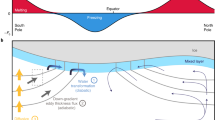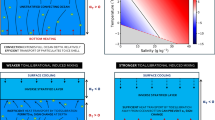Abstract
Cassini observations imply that there is a global ocean underneath Enceladus’s ice shell with hydrothermal seafloor activity. Previous numerical simulations showed that convection in Enceladus’s unconsolidated core may produce a heterogeneous seafloor heat flux and hydrothermal activity, potentially explaining the South Polar ice thinning and plume activity. How the ocean transports heat and hydrothermal products is the missing piece of the Enceladus puzzle. Here we perform three-dimensional numerical simulations of the ocean dynamics using a very heterogeneous bottom boundary condition from three-dimensional hydrothermal core simulations. We gradually increase the heterogeneity amplitude of the bottom heat flux until its peak-to-peak value reaches 60 times its mean. We show that a strong zonal flow diminishes low-latitude heat transfer, whereas the heat flux remains efficient in polar regions, which explains the ice shell variations derived from gravity and topography observations. Using passive tracers, we predict rising times of hours to weeks, which are compatible with previous predictions. Our simulations confirm that a strong heterogeneous seafloor heat flux concentrates upwellings at the South Pole, thus efficiently transporting organic matter from hydrothermal vents to erupting plumes.
This is a preview of subscription content, access via your institution
Access options
Access Nature and 54 other Nature Portfolio journals
Get Nature+, our best-value online-access subscription
$32.99 / 30 days
cancel any time
Subscribe to this journal
Receive 12 digital issues and online access to articles
$119.00 per year
only $9.92 per issue
Buy this article
- Purchase on SpringerLink
- Instant access to full article PDF
Prices may be subject to local taxes which are calculated during checkout



Similar content being viewed by others
Data availability
The datasets generated during or analysed during the current study are available from the corresponding author on reasonable request. Correspondence and requests for materials should be addressed to M.B. (mathieu.bouffard@univ-nantes.fr).
Code availability
The source code is available at https://bitbucket.org/mathieubouffard/source_code_enceladus/src/master/.
References
Čadek, O. et al. Long-term stability of Enceladus’ uneven ice shell. Icarus 319, 476–484 (2019).
Iess, L. et al. The gravity field and interior structure of Enceladus. Science 344, 78–80 (2014).
Choblet, G. et al. Powering prolonged hydrothermal activity inside Enceladus. Nat. Astron. 1, 841–847 (2017).
Olson, P. & Christensen, U. R. The time-averaged magnetic field in numerical dynamos with non-uniform boundary heat flow. Geophys. J. Int. 151, 809–823 (2002).
Aurnou, J., Andreadis, S., Zhu, L. & Olson, P. Experiments on convection in Earth’s core tangent cylinder. Earth Planet. Sci. Lett. 212, 119–134 (2003).
Gastine, T., Wicht, J. & Aubert, J. Scaling regimes in spherical shell rotating convection. J. Fluid Mech. 808, 690–732 (2016).
Busse, F. H. Thermal instabilities in rapidly rotating systems. J. Fluid Mech. 44, 441–460 (1970).
Beuthe, M. Crustal control of dissipative ocean tides in Enceladus and other icy moons. Icarus 280, 278–299 (2016).
Hsu, H. W. et al. Ongoing hydrothermal activities within Enceladus. Nature 519, 207–210 (2015).
Sekine, Y. et al. High-temperature water–rock interactions and hydrothermal environments in the chondrite-like core of Enceladus. Nat. Commun. 6, 8604 (2015).
Schoenfeld, A. M. et al. Particle entrainment and rotating convection in Enceladus’ ocean. Commun. Earth Environ. 4, 28 (2023).
Jansen, M. F., Kang, W., Kite, E. S. & Zeng, Y. Energetic constraints on ocean circulations of icy ocean worlds. Planet. Sci. J. 4, 117 (2023).
Zeng, Y. & Jansen, M. F. Ocean circulation on Enceladus with a high- versus low-salinity ocean. Planet. Sci. J. 2, 151 (2021).
Kang, W., Mittal, T., Bire, S., Campin, J. M. & Marshall, J. How does salinity shape ocean circulation and ice geometry on Enceladus and other icy satellites? Sci. Adv. 8, eabm4665 (2022).
Ashkenazy, Y. & Tziperman, E. Dynamic Europa ocean shows transient Taylor columns and convection driven by ice melting and salinity. Nat. Commun. 12, 6376 (2021).
Lobo, A. H., Thompson, A. F., Vance, S. D. & Tharimena, S. A pole-to-equator ocean overturning circulation on Enceladus. Nat. Geosci. 14, 185–189 (2021).
Hemingway, D. J., Rudolph, M. L. & Manga, M. Cascading parallel fractures on Enceladus. Nat. Astron. 4, 234–239 (2020).
Souček, O. et al. Tidal dissipation in Enceladus’ uneven, fractured ice shell. Icarus 328, 218–231 (2019).
Kang, W. & Flierl, G. Spontaneous formation of geysers at only one pole on Enceladus’s ice shell. Proc. Natl Acad. Sci. USA 117, 14764–14768 (2020).
Jones, H. & Marshall, J. Convection with rotation in a neutral ocean: a study of open-ocean deep convection. J. Phys. Oceanogr. 23, 1009–1039 (1993).
Haine, T. W. & Marshall, J. Gravitational, symmetric, and baroclinic instability of the ocean mixed layer. J. Phys. Oceanogr. 28, 634–658 (1998).
Bush, J. W. & Woods, A. W. Vortex generation by line plumes in a rotating stratified fluid. J. Fluid Mech. 388, 289–313 (1999).
Amit, H., Aubert, J. & Hulot, G. Stationary, oscillating or drifting mantle-driven geomagnetic flux patches? J. Geophys. Res.: Solid Earth https://doi.org/10.1029/2009JB006542 (2010).
Amit, H. et al. Cooling patterns in rotating thin spherical shells – application to Titan’s subsurface ocean. Icarus 338, 113509 (2020).
Terra-Nova, F. et al. The influence of heterogeneous seafloor heat flux on the cooling patterns of Ganymede’s and Titan’s subsurface oceans. Icarus 389, 115232 (2023).
Glein, C. R., Zolotov, M. Y. & Shock, E. L. The oxidation state of hydrothermal systems on early Enceladus. Icarus 197, 157–163 (2008).
Couston, L. A. & Siegert, M. Dynamic flows create potentially habitable conditions in Antarctic subglacial lakes. Sci. Adv. 7, eabc3972 (2021).
Postberg, F. et al. Macromolecular organic compounds from the depths of Enceladus. Nature 558, 564–568 (2018).
Choblet, G. et al. Enceladus as a potential oasis for life: science goals and investigations for future explorations. Exp. Astron. 54, 809–847 (2022).
Aubert, J., Aurnou, J. & Wicht, J. The magnetic structure of convection-driven numerical dynamos. Geophys. J. Int. 172, 945–956 (2008).
Aubert, J., Gastine, T. & Fournier, A. Spherical convective dynamos in the rapidly rotating asymptotic regime. J. Fluid Mech. 813, 558–593 (2017).
Schaeffer, N., Jault, D., Nataf, H. C. & Fournier, A. Turbulent geodynamo simulations: a leap towards Earth’s core. Geophys. J. Int. 211, 1–29 (2017).
Howett, C. J. A., Spencer, J. R., Pearl, J. & Segura, M. High heat flux from Enceladus’ south polar region measured using 10–600 cm−1 Cassini/CIRS data. J. Geophys. Res.: Planets https://doi.org/10.1029/2010JE003718 (2011).
Ingersoll, A. P. & Pankine, A. A. Subsurface heat transfer on Enceladus: conditions under which melting occurs. Icarus 206, 594–607 (2010).
Kite, E. S. & Rubin, A. M. Sustained eruptions on Enceladus explained by turbulent dissipation in tiger stripes. Proc. Natl Acad. Sci. USA 113, 3972–3975 (2016).
Bouffard, M. et al. A particle-in-cell method for studying double-diffusive convection in the liquid layers of planetary interiors. J. Comput. Phys. 346, 552–571 (2017).
Acknowledgements
Simulations were performed at the CCIPL facility (Centre de Calcul Intensif des Pays de la Loire, Nantes, France). We acknowledge financial support from the French Agence Nationale de Recherche (Project ANR COLOSSE and Grant No. ANR-2020-CE49-0010 to G.C). F.T.-N. is supported by the Centre National des Études Spatiales France. O.Č. is a member of the Nečas Center for Numerical Modeling. H.A. acknowledges financial support from the French Agence Nationale de Recherche, project DYRE-COMB (grant ANR-22-CE49-0016-01).
Author information
Authors and Affiliations
Contributions
G.C. conceived the idea for the study. M.B. modified the PARODY code, performed the simulations, processed the data, wrote the manuscript and made the figures. All authors contributed to data analysis and interpretation, as well as manuscript writing and wording.
Corresponding author
Ethics declarations
Competing interests
The authors declare no competing interests.
Peer review
Peer review information
Nature Astronomy thanks John Marshall, Steven Vance and the other, anonymous, reviewer(s) for their contribution to the peer review of this work.
Additional information
Publisher’s note Springer Nature remains neutral with regard to jurisdictional claims in published maps and institutional affiliations.
Supplementary information
Supplementary Information
Supplementary sections, Tables 1 and 2, and Figs. 1–9.
Rights and permissions
Springer Nature or its licensor (e.g. a society or other partner) holds exclusive rights to this article under a publishing agreement with the author(s) or other rightsholder(s); author self-archiving of the accepted manuscript version of this article is solely governed by the terms of such publishing agreement and applicable law.
About this article
Cite this article
Bouffard, M., Choblet, G., Amit, H. et al. Seafloor hydrothermal control over ocean dynamics in Enceladus. Nat Astron 9, 650–657 (2025). https://doi.org/10.1038/s41550-025-02490-1
Received:
Accepted:
Published:
Issue date:
DOI: https://doi.org/10.1038/s41550-025-02490-1



